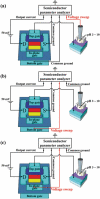High-performance extended-gate ion-sensitive field-effect transistors with multi-gate structure for transparent, flexible, and wearable biosensors
- PMID: 32939162
- PMCID: PMC7476522
- DOI: 10.1080/14686996.2020.1775477
High-performance extended-gate ion-sensitive field-effect transistors with multi-gate structure for transparent, flexible, and wearable biosensors
Abstract
In this study, we developed a high-performance extended-gate ion-sensitive field-effect transistor (EG-ISFET) sensor on a flexible polyethylene naphthalate (PEN) substrate. The EG-ISFET sensor comprises a tin dioxide (SnO2) extended gate, which acts as a detector, and an amorphous indium-gallium-zinc-oxide (a-IGZO) thin-film transistor (TFT) for a transducer. In order to self-amplify the sensitivity of the pH sensors, we designed a uniquely-structured a-IGZO TFT transducer with a high-k engineered top gate insulator consisting of a silicon dioxide/tantalum pentoxide (SiO2/Ta2O5) stack, a floating layer under the channel, and a control gate coplanar with the channel. The SiO2/Ta2O5 stacked top gate insulator and in-plane control gate significantly contribute to capacitive coupling, enabling the amplification of sensitivity to be enlarged compared to conventional dual-gate transducers. For a pH sensing method suitable for EG-ISFET sensors, we propose an in-plane control gate (IG) sensing mode, instead of conventional single-gate (SG) or dual-gate (DG) sensing modes. As a result, a pH sensitivity of 2364 mV/pH was achieved at room temperature - this is significantly superior to the Nernstian limit (59.15 mV/pH at room temperature). In addition, we found that non-ideal behavior was improved in hysteresis and drift measurements. Therefore, the proposed transparent EGISFFET sensor with an IG sensing mode is expected to become a promising platform for flexible and wearable biosensing applications.
Keywords: 102 Porous / Nanoporous / Nanostructured materials; 208 Sensors and actuators; 306 Thin film / Coatings; Extended-gate ion-sensitive field-effect transistor; capacitive coupling; flexible; high-k engineered gate oxide; in-plane control gate; polyethylene naphthalate.
© 2020 The Author(s). Published by National Institute for Materials Science in partnership with Taylor & Francis Group.
Conflict of interest statement
No potential conflict of interest was reported by the authors.
Figures







Similar articles
-
Highly Sensitive and Transparent Urea-EnFET Based Point-of-Care Diagnostic Test Sensor with a Triple-Gate a-IGZO TFT.Sensors (Basel). 2021 Jul 12;21(14):4748. doi: 10.3390/s21144748. Sensors (Basel). 2021. PMID: 34300488 Free PMC article.
-
Fully Transparent and Sensitivity-Programmable Amorphous Indium-Gallium-Zinc-Oxide Thin-Film Transistor-Based Biosensor Platforms with Resistive Switching Memories.Sensors (Basel). 2021 Jun 28;21(13):4435. doi: 10.3390/s21134435. Sensors (Basel). 2021. PMID: 34203521 Free PMC article.
-
Ultrasensitive Coplanar Dual-Gate ISFETs for Point-of-Care Biomedical Applications.ACS Omega. 2020 May 27;5(22):12809-12815. doi: 10.1021/acsomega.0c00427. eCollection 2020 Jun 9. ACS Omega. 2020. PMID: 32548464 Free PMC article.
-
Functionalized Organic Thin Film Transistors for Biosensing.Acc Chem Res. 2019 Feb 19;52(2):277-287. doi: 10.1021/acs.accounts.8b00448. Epub 2019 Jan 8. Acc Chem Res. 2019. PMID: 30620566 Review.
-
Dual-gate thin-film transistors, integrated circuits and sensors.Adv Mater. 2011 Aug 2;23(29):3231-42. doi: 10.1002/adma.201101493. Epub 2011 Jun 14. Adv Mater. 2011. PMID: 21671446 Review.
Cited by
-
Comparison of NH3 and N2O Plasma Treatments on Bi2O3 Sensing Membranes Applied in an Electrolyte-Insulator-Semiconductor Structure.Membranes (Basel). 2022 Feb 5;12(2):188. doi: 10.3390/membranes12020188. Membranes (Basel). 2022. PMID: 35207109 Free PMC article.
-
Recent Progress in Flexible and Wearable All Organic Photoplethysmography Sensors for SpO2 Monitoring.Adv Sci (Weinh). 2023 Nov;10(31):e2302752. doi: 10.1002/advs.202302752. Epub 2023 Sep 23. Adv Sci (Weinh). 2023. PMID: 37740697 Free PMC article. Review.
-
Dual-Gate Organic Thin-Film Transistor and Multiplexer Chips for the Next Generation of Flexible EG-ISFET Sensor Chips.Sensors (Basel). 2023 Jul 21;23(14):6577. doi: 10.3390/s23146577. Sensors (Basel). 2023. PMID: 37514871 Free PMC article.
-
Sensitivity, Noise and Resolution in a BEOL-Modified Foundry-Made ISFET with Miniaturized Reference Electrode for Wearable Point-of-Care Applications.Sensors (Basel). 2021 Mar 4;21(5):1779. doi: 10.3390/s21051779. Sensors (Basel). 2021. PMID: 33806584 Free PMC article.
References
-
- Flinck M, Kramer SH, Pedersen SF.. Roles of pH in control of cell proliferation. Acta Physiol. 2018;223(3):e13068. - PubMed
-
- Boron WF. Regulation of intracellular pH. Adv Physiol Educ. 2004;28(4):160–179. - PubMed
-
- Ronkainen NJ, Halsall HB, Heineman WR. Electrochemical biosensors. Chem Soc Rev. 2010;39(5):1747–1763. - PubMed
-
- Chen K-I, Li B-R, Chen Y-T. Silicon nanowire field-effect transistor-based biosensors for biomedical diagnosis and cellular recording investigation. Nano Today. 2011;6(2):131–154.
LinkOut - more resources
Full Text Sources
Other Literature Sources
Research Materials
